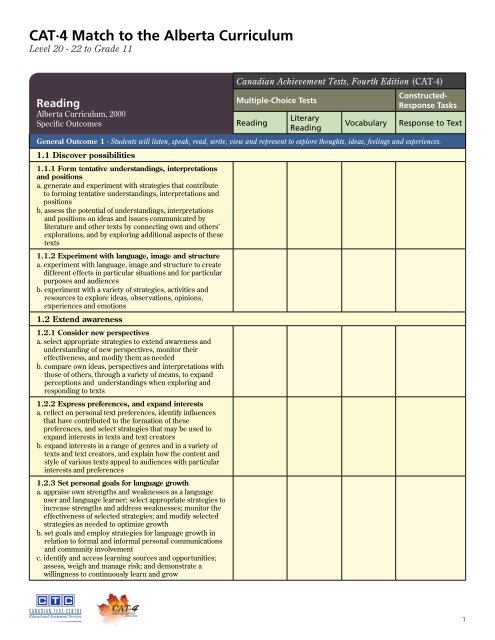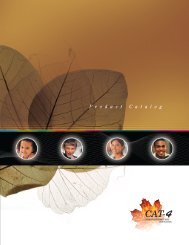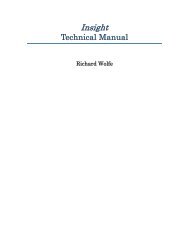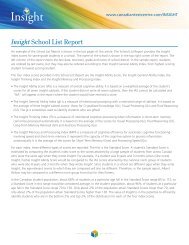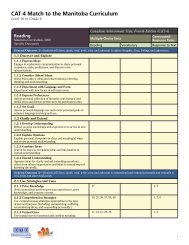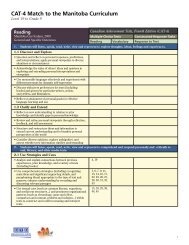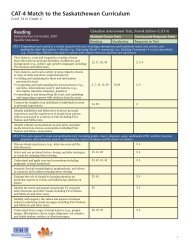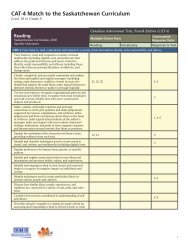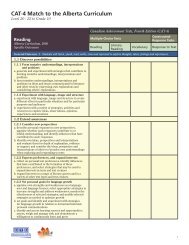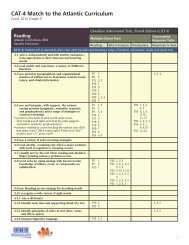CATâ4 Match to the Alberta Curriculum - Canadian Test Centre
CATâ4 Match to the Alberta Curriculum - Canadian Test Centre
CATâ4 Match to the Alberta Curriculum - Canadian Test Centre
Create successful ePaper yourself
Turn your PDF publications into a flip-book with our unique Google optimized e-Paper software.
CAT∙4 <strong>Match</strong> <strong>to</strong> <strong>the</strong> <strong>Alberta</strong> <strong>Curriculum</strong><br />
Level 20 - 22 <strong>to</strong> Grade 11<br />
Reading<br />
<strong>Alberta</strong> <strong>Curriculum</strong>, 2000<br />
Specific Outcomes<br />
<strong>Canadian</strong> Achievement <strong>Test</strong>s, Fourth Edition (CAT·4)<br />
Multiple-Choice <strong>Test</strong>s<br />
Reading<br />
Literary<br />
Reading<br />
Vocabulary<br />
Constructed-<br />
Response Tasks<br />
Response <strong>to</strong> Text<br />
General Outcome 1 - Students will listen, speak, read, write, view and represent <strong>to</strong> explore thoughts, ideas, feelings and experiences.<br />
1.1 Discover possibilities<br />
1.1.1 Form tentative understandings, interpretations<br />
and positions<br />
a. generate and experiment with strategies that contribute<br />
<strong>to</strong> forming tentative understandings, interpretations and<br />
positions<br />
b. assess <strong>the</strong> potential of understandings, interpretations<br />
and positions on ideas and issues communicated by<br />
literature and o<strong>the</strong>r texts by connecting own and o<strong>the</strong>rs’<br />
explorations, and by exploring additional aspects of <strong>the</strong>se<br />
texts<br />
1.1.2 Experiment with language, image and structure<br />
a. experiment with language, image and structure <strong>to</strong> create<br />
different effects in particular situations and for particular<br />
purposes and audiences<br />
b. experiment with a variety of strategies, activities and<br />
resources <strong>to</strong> explore ideas, observations, opinions,<br />
experiences and emotions<br />
1.2 Extend awareness<br />
1.2.1 Consider new perspectives<br />
a. select appropriate strategies <strong>to</strong> extend awareness and<br />
understanding of new perspectives, moni<strong>to</strong>r <strong>the</strong>ir<br />
effectiveness, and modify <strong>the</strong>m as needed<br />
b. compare own ideas, perspectives and interpretations with<br />
those of o<strong>the</strong>rs, through a variety of means, <strong>to</strong> expand<br />
perceptions and understandings when exploring and<br />
responding <strong>to</strong> texts<br />
1.2.2 Express preferences, and expand interests<br />
a. reflect on personal text preferences, identify influences<br />
that have contributed <strong>to</strong> <strong>the</strong> formation of <strong>the</strong>se<br />
preferences, and select strategies that may be used <strong>to</strong><br />
expand interests in texts and text crea<strong>to</strong>rs<br />
b. expand interests in a range of genres and in a variety of<br />
texts and text crea<strong>to</strong>rs, and explain how <strong>the</strong> content and<br />
style of various texts appeal <strong>to</strong> audiences with particular<br />
interests and preferences<br />
1.2.3 Set personal goals for language growth<br />
a. appraise own strengths and weaknesses as a language<br />
user and language learner; select appropriate strategies <strong>to</strong><br />
increase strengths and address weaknesses; moni<strong>to</strong>r <strong>the</strong><br />
effectiveness of selected strategies; and modify selected<br />
strategies as needed <strong>to</strong> optimize growth<br />
b. set goals and employ strategies for language growth in<br />
relation <strong>to</strong> formal and informal personal communications<br />
and community involvement<br />
c. identify and access learning sources and opportunities;<br />
assess, weigh and manage risk; and demonstrate a<br />
willingness <strong>to</strong> continuously learn and grow<br />
1
CAT∙4 <strong>Match</strong> <strong>to</strong> <strong>the</strong> <strong>Alberta</strong> <strong>Curriculum</strong><br />
Level 20 - 22 <strong>to</strong> Grade 11<br />
Reading<br />
<strong>Alberta</strong> <strong>Curriculum</strong>, 2000<br />
Specific Outcomes<br />
<strong>Canadian</strong> Achievement <strong>Test</strong>s, Fourth Edition (CAT·4)<br />
Multiple-Choice <strong>Test</strong>s<br />
Reading<br />
Literary<br />
Reading<br />
Vocabulary<br />
Constructed-<br />
Response Tasks<br />
Response <strong>to</strong> Text<br />
General Outcome 2 - Students will listen, speak, read, write, view and represent <strong>to</strong> comprehend literature and o<strong>the</strong>r texts in oral, print,<br />
visual and multimedia forms, and respond personally, critically and creatively.<br />
2.1 Construct meaning from text and context<br />
2.1.1 Discern and analyze context<br />
a. describe <strong>the</strong> text crea<strong>to</strong>r’s purpose, and analyze <strong>the</strong> target<br />
audience<br />
b. describe how societal forces can influence <strong>the</strong> production<br />
of texts<br />
c. explain <strong>the</strong> relationship between text and context in<br />
terms of how elements in an environment can affect <strong>the</strong><br />
way in which a text is created<br />
d. identify <strong>the</strong> impact that personal context—experience,<br />
prior knowledge—has on constructing meaning from a<br />
text<br />
2.1.2 Understand and interpret content<br />
a. use a variety of strategies <strong>to</strong> comprehend literature and<br />
o<strong>the</strong>r texts and develop strategies for close reading of<br />
literature in order <strong>to</strong> understand contextual elements<br />
b. describe how supporting ideas and supporting details<br />
streng<strong>the</strong>n a text’s controlling idea<br />
c. describe <strong>the</strong> relationships among plot, setting, character,<br />
atmosphere and <strong>the</strong>me when studying a narrative<br />
d. compare <strong>the</strong> personality traits, roles, relationships,<br />
motivations, attitudes, values and archetypal qualities,<br />
when appropriate, of characters developed/persons<br />
presented in literature and o<strong>the</strong>r texts<br />
e. describe a text crea<strong>to</strong>r’s <strong>to</strong>ne and register; and identify<br />
<strong>the</strong> moral and ethical stance communicated by a text<br />
f. interpret figurative language, symbol and allusions;<br />
recognize imagery; and explain how imagery contributes<br />
<strong>to</strong> atmosphere, characterization and <strong>the</strong>me in a text<br />
g. analyze visual and aural elements, and explain how <strong>the</strong>y<br />
contribute <strong>to</strong> <strong>the</strong> meaning of texts<br />
h. describe <strong>the</strong> relationship between audience response <strong>to</strong><br />
<strong>the</strong> content of a presentation and audience response <strong>to</strong><br />
<strong>the</strong> performance of <strong>the</strong> presenter<br />
2.1.3 Engage prior knowledge<br />
a. reflect on and describe strategies used <strong>to</strong> engage prior<br />
knowledge as a means of assisting comprehension of new<br />
texts; and select, moni<strong>to</strong>r and modify strategies as needed<br />
b. assess personal expectations for texts <strong>to</strong> be studied in<br />
light of prior experiences with and observations about<br />
similar contexts, content and text forms<br />
c. use metacognitive strategies <strong>to</strong> understand how<br />
knowledge of rhe<strong>to</strong>rical devices, textual elements and<br />
structures used in previously studied texts contributes <strong>to</strong><br />
understanding new texts<br />
d. classify <strong>the</strong> genre/form of new texts according <strong>to</strong><br />
attributes of genres/forms previously studied<br />
20<br />
1, 2, 4, 6, 7, 9,<br />
11, 13, 16, 25,<br />
26, 28, 33, 36,<br />
38<br />
2, 4, 6, 9, 13,<br />
14, 15, 18, 19,<br />
20, 26, 27, 29,<br />
31, 32, 33, 35,<br />
36, 37, 39<br />
14, 15, 16, 17,<br />
18, 19, 20, 21,<br />
22, 23, 24, 25,<br />
26, 27, 28, 29,<br />
30<br />
2
CAT∙4 <strong>Match</strong> <strong>to</strong> <strong>the</strong> <strong>Alberta</strong> <strong>Curriculum</strong><br />
Level 20 - 22 <strong>to</strong> Grade 11<br />
Reading<br />
<strong>Alberta</strong> <strong>Curriculum</strong>, 2000<br />
Specific Outcomes<br />
2.1.4 Use reference strategies and reference<br />
technologies<br />
a. use a variety of appropriate reference strategies and<br />
reference technologies <strong>to</strong> aid understanding<br />
b. create and use own reference materials <strong>to</strong> aid<br />
understanding<br />
<strong>Canadian</strong> Achievement <strong>Test</strong>s, Fourth Edition (CAT·4)<br />
Multiple-Choice <strong>Test</strong>s<br />
Reading<br />
Literary<br />
Reading<br />
2.2 Understand and appreciate textual forms, elements and techniques<br />
2.2.1 Relate form, structure and medium <strong>to</strong> purpose,<br />
audience and content<br />
a. identify a variety of text forms, including communications<br />
forms and literary forms; and describe <strong>the</strong> relationships<br />
of form <strong>to</strong> purpose and content<br />
b. describe audience fac<strong>to</strong>rs that may have influenced a text<br />
crea<strong>to</strong>r’s choice of form and medium<br />
c. explain how a variety of organizational patterns and<br />
structural features contribute <strong>to</strong> purpose and content<br />
d. analyze <strong>the</strong> effect of medium on message<br />
2.2.2 Relate elements, devices and techniques <strong>to</strong><br />
created effects<br />
a. explain how rhe<strong>to</strong>rical devices and stylistic techniques<br />
used in print and nonprint texts create clarity, coherence<br />
and emphasis<br />
b. explain how various textual elements and stylistic<br />
techniques contribute <strong>to</strong> <strong>the</strong> creation of atmosphere, <strong>to</strong>ne<br />
and voice<br />
c. analyze <strong>the</strong> use of irony and satire <strong>to</strong> create effects in<br />
print and nonprint texts<br />
d. describe <strong>the</strong> effects of musical devices, figures of speech<br />
and sensory details in print and nonprint texts<br />
e. explain <strong>the</strong> contribution of motif and symbol <strong>to</strong><br />
controlling idea and <strong>the</strong>me<br />
f. differentiate between effective and ineffective<br />
presentations, and analyze <strong>the</strong> differences g. analyze<br />
persuasive techniques used in a variety of print and<br />
nonprint texts<br />
3, 5, 12, 15,<br />
19, 22, 24, 29,<br />
31, 34, 35<br />
1, 5, 7, 12, 21,<br />
25, 28, 34, 40<br />
Vocabulary<br />
1, 2, 3, 4, 5, 6,<br />
7, 8, 9, 10, 11,<br />
12, 13<br />
Constructed-<br />
Response Tasks<br />
Response <strong>to</strong> Text<br />
3
CAT∙4 <strong>Match</strong> <strong>to</strong> <strong>the</strong> <strong>Alberta</strong> <strong>Curriculum</strong><br />
Level 20 - 22 <strong>to</strong> Grade 11<br />
Reading<br />
<strong>Alberta</strong> <strong>Curriculum</strong>, 2000<br />
Specific Outcomes<br />
2.3 Respond <strong>to</strong> a variety of print and nonprint texts<br />
2.3.1 Connect self, text, culture and milieu<br />
a. identify and consider personal, moral, ethical and cultural<br />
perspectives when studying literature and o<strong>the</strong>r texts;<br />
and reflect on and moni<strong>to</strong>r how perspectives change as a<br />
result of interpretation and discussion<br />
b. respond personally and analytically <strong>to</strong> ideas developed<br />
in works of literature and o<strong>the</strong>r texts; and analyze <strong>the</strong><br />
ways in which ideas are reflected in personal and cultural<br />
opinions, values, beliefs and perspectives<br />
c. explain how <strong>the</strong> choices and motives of characters and<br />
people presented in texts may provide insight in<strong>to</strong> <strong>the</strong><br />
choices and motives of self and o<strong>the</strong>rs<br />
d. identify and examine ways in which cultural and societal<br />
influences are reflected in a variety of <strong>Canadian</strong> and<br />
international texts<br />
2.3.2 Evaluate <strong>the</strong> verisimilitude, appropriateness and<br />
significance of print and nonprint texts<br />
a. identify criteria <strong>to</strong> evaluate <strong>the</strong> effectiveness of texts,<br />
moni<strong>to</strong>r <strong>the</strong> effectiveness of <strong>the</strong> criteria, and modify <strong>the</strong><br />
criteria as needed<br />
b. assess <strong>the</strong> appropriateness of own and o<strong>the</strong>rs’<br />
understandings and interpretations of works of literature<br />
and o<strong>the</strong>r texts, by referring <strong>to</strong> <strong>the</strong> works and texts for<br />
supporting or contradic<strong>to</strong>ry evidence<br />
c. analyze and assess settings and plots in terms of created<br />
reality and plausibility<br />
d. analyze and assess character and characterization<br />
in terms of consistency of behaviour, motivation and<br />
plausibility, and in terms of contribution <strong>to</strong> <strong>the</strong>me<br />
e. analyze and assess images in print and nonprint texts in<br />
terms of created reality and appropriateness <strong>to</strong> purpose<br />
and audience<br />
f. assess <strong>the</strong> significance of a text’s <strong>the</strong>me or controlling<br />
idea, and <strong>the</strong> adequacy, relevance and effectiveness of its<br />
supporting details, examples or illustrations, and content<br />
in general<br />
2.3.3 Appreciate <strong>the</strong> effectiveness and artistry of print<br />
and nonprint texts<br />
a. use terminology appropriate <strong>to</strong> <strong>the</strong> forms studied for<br />
discussing and appreciating <strong>the</strong> effectiveness and artistry<br />
of a variety of text forms<br />
b. describe <strong>the</strong> effectiveness of various texts, including<br />
media texts, for presenting feelings, ideas and<br />
information, and for evoking response<br />
<strong>Canadian</strong> Achievement <strong>Test</strong>s, Fourth Edition (CAT·4)<br />
Multiple-Choice <strong>Test</strong>s<br />
Reading<br />
8, 10, 17, 18,<br />
27, 30, 39<br />
14, 21, 23, 31,<br />
32, 37, 40<br />
Literary<br />
Reading<br />
3, 11, 16, 22,<br />
23, 24, 30, 38<br />
8, 10, 17<br />
Vocabulary<br />
Constructed-<br />
Response Tasks<br />
Response <strong>to</strong> Text<br />
4
CAT∙4 <strong>Match</strong> <strong>to</strong> <strong>the</strong> <strong>Alberta</strong> <strong>Curriculum</strong><br />
Level 20 - 22 <strong>to</strong> Grade 11<br />
Writing<br />
<strong>Alberta</strong> <strong>Curriculum</strong>, 2000<br />
Specific Outcomes<br />
<strong>Canadian</strong> Achievement <strong>Test</strong>s, Fourth Edition (CAT·4)<br />
Multiple-Choice <strong>Test</strong>s<br />
Writing<br />
Spelling<br />
Conventions<br />
Constructed-Response Tasks<br />
Writing<br />
General Outcome 3 - Students will listen, speak, read, write, view and represent <strong>to</strong> manage ideas and information.<br />
3.1 Determine inquiry or research requirements<br />
3.1.1 Focus on purpose and presentation form<br />
a. select and moni<strong>to</strong>r <strong>the</strong> effectiveness of strategies <strong>to</strong><br />
determine <strong>the</strong> depth and breadth of inquiry or research<br />
and <strong>to</strong> identify <strong>the</strong> purpose, audience and form of<br />
presentation<br />
b. describe <strong>the</strong> purpose of inquiry or research and <strong>the</strong><br />
scope of <strong>the</strong> inquiry or research <strong>to</strong>pic; identify <strong>the</strong><br />
target audience; and identify <strong>the</strong> potential form for <strong>the</strong><br />
presentation of inquiry or research findings, when<br />
applicable<br />
c. refine <strong>the</strong> purpose of inquiry or research by limiting or<br />
expanding <strong>the</strong> <strong>to</strong>pic as appropriate<br />
3.1.2 Plan inquiry or research, and identify<br />
information needs and sources<br />
a. reflect on and describe strategies for developing an<br />
inquiry or research plan that will foster understanding,<br />
select and moni<strong>to</strong>r appropriate strategies, and modify<br />
strategies as needed <strong>to</strong> plan inquiry or research<br />
effectively<br />
b. select from a reper<strong>to</strong>ire of effective strategies <strong>to</strong> develop<br />
appropriate inquiry or research plans that will address<br />
<strong>the</strong> <strong>to</strong>pic and satisfy contextual and presentation<br />
requirements<br />
c. determine <strong>the</strong> breadth and depth of prior knowledge,<br />
and formulate questions <strong>to</strong> determine and categorize<br />
information needs and <strong>to</strong> guide <strong>the</strong> collection of required<br />
information<br />
d. identify and predict <strong>the</strong> usefulness of information sources<br />
intended <strong>to</strong> fill gaps between prior knowledge and<br />
required information<br />
e. identify and select potential strategies and technologies<br />
for ga<strong>the</strong>ring, generating and recording information<br />
3.2 Follow a plan of inquiry<br />
3.2.1 Select, record and organize information<br />
a. reflect on and describe strategies that may be used<br />
<strong>to</strong> select, record and organize information; select and<br />
moni<strong>to</strong>r appropriate strategies; and modify selected<br />
strategies as needed<br />
b. select information and o<strong>the</strong>r material appropriate <strong>to</strong><br />
purpose from a variety of print and nonprint sources<br />
c. record information accurately and completely; and<br />
document and reference sources, as appropriate<br />
d. organize information logically<br />
e. observe guidelines for Internet use<br />
5
CAT∙4 <strong>Match</strong> <strong>to</strong> <strong>the</strong> <strong>Alberta</strong> <strong>Curriculum</strong><br />
Level 20 - 22 <strong>to</strong> Grade 11<br />
Writing<br />
<strong>Alberta</strong> <strong>Curriculum</strong>, 2000<br />
Specific Outcomes<br />
3.2.2 Evaluate sources, and assess information<br />
a. reflect on and describe strategies <strong>to</strong> evaluate information<br />
sources for credibility and bias and for quality; and select,<br />
moni<strong>to</strong>r and modify strategies as needed <strong>to</strong> evaluate<br />
sources and detect bias<br />
b. assess information sources for appropriateness <strong>to</strong><br />
purpose, audience and presentation form<br />
c. assess <strong>the</strong> accuracy, completeness, currency and<br />
relevance of information selected from sources; and<br />
assess <strong>the</strong> appropriateness of <strong>the</strong> information for purpose<br />
d. identify and describe possible biases of sources, and<br />
describe <strong>the</strong> possible effects of such biases on <strong>the</strong><br />
credibility of information<br />
3.2.3 Form generalizations and conclusions<br />
a. form generalizations by integrating new information with<br />
prior knowledge<br />
b. draw conclusions that are appropriate <strong>to</strong> findings, reflect<br />
own understandings and are consistent with <strong>the</strong> identified<br />
<strong>to</strong>pic, purpose and situation<br />
c. distinguish between support and generalization, and<br />
provide support for generalizations and conclusions<br />
<strong>Canadian</strong> Achievement <strong>Test</strong>s, Fourth Edition (CAT·4)<br />
Multiple-Choice <strong>Test</strong>s<br />
Writing<br />
Spelling<br />
Conventions<br />
Constructed-Response Tasks<br />
Writing<br />
3.2.4 Review inquiry or research process and findings<br />
a. reflect on and assess <strong>the</strong> effectiveness of strategies used<br />
<strong>to</strong> guide inquiry or research<br />
b. identify strategies <strong>to</strong> improve future inquiry or research,<br />
and moni<strong>to</strong>r <strong>the</strong> effectiveness of <strong>the</strong>se strategies<br />
c. review <strong>the</strong> appropriateness, accuracy and significance<br />
of findings, conclusions and generalizations drawn<br />
from ga<strong>the</strong>red data and information; prepare a detailed<br />
record of references; determine how best <strong>to</strong> share <strong>the</strong><br />
information; and determine next steps, if any<br />
d. seek feedback from o<strong>the</strong>rs and use own reflections <strong>to</strong><br />
evaluate <strong>the</strong> entire inquiry or research process, strive for<br />
craftsmanship and accuracy, and take pride in efforts and<br />
accomplishments<br />
General Outcome 4 - Students will listen, speak, read, write, view and represent <strong>to</strong> create oral, print, visual and multimedia texts, and<br />
enhance <strong>the</strong> clarity and artistry of communication.<br />
4.1 Develop and present a variety of print and nonprint texts<br />
4.1.1 Assess text creation context<br />
a. reflect on <strong>the</strong> purposes for text creation and on own<br />
motives for selecting strategies <strong>to</strong> engage an audience;<br />
and consider potential consequences of choices regarding<br />
text creation<br />
b. identify purpose and target audience for text creation,<br />
and select strategies <strong>to</strong> accomplish purpose and engage<br />
audience<br />
c. address audience fac<strong>to</strong>rs that affect text creation<br />
d. analyze expectations and constraints of a communication<br />
situation, and select preferred strategies <strong>to</strong> address<br />
expectations and constraints<br />
6
CAT∙4 <strong>Match</strong> <strong>to</strong> <strong>the</strong> <strong>Alberta</strong> <strong>Curriculum</strong><br />
Level 20 - 22 <strong>to</strong> Grade 11<br />
Writing<br />
<strong>Alberta</strong> <strong>Curriculum</strong>, 2000<br />
Specific Outcomes<br />
4.1.2 Consider and address form, structure and<br />
medium<br />
a. select a text form appropriate <strong>to</strong> <strong>the</strong> purpose for text<br />
creation and consistent with <strong>the</strong> content <strong>to</strong> be presented<br />
in <strong>the</strong> text<br />
b. explore a variety of structures consistent with form,<br />
content and purpose when creating texts<br />
c. select an effective medium appropriate <strong>to</strong> content and<br />
context, and explain its use<br />
d. understand <strong>the</strong> concept of convention; and apply it<br />
<strong>to</strong> oral, print, visual and multimedia text forms when<br />
appropriate<br />
4.1.3 Develop content<br />
a. take ownership of text creation, by selecting or crafting<br />
a <strong>to</strong>pic, concept or idea that is personally meaningful and<br />
engaging<br />
b. recognize and assess personal variables and contextual<br />
variables that influence <strong>the</strong> selection of a <strong>to</strong>pic, concept<br />
or idea; and address <strong>the</strong>se variables <strong>to</strong> increase <strong>the</strong><br />
likelihood of successful text creation<br />
c. establish a focus for text creation, and communicate<br />
scope by framing an effective controlling idea or<br />
describing a strong unifying effect<br />
d. develop supporting details, by using developmental aids<br />
appropriate <strong>to</strong> form and purpose<br />
e. develop content <strong>to</strong> support a controlling idea or <strong>to</strong><br />
produce a unifying effect<br />
f. develop content appropriate <strong>to</strong> form and context<br />
g. incorporate effective examples from personal experience,<br />
concepts and ideas from exploration, and findings from<br />
inquiry and research in<strong>to</strong> created texts, when appropriate<br />
4.1.4 Use production, publication and presentation<br />
strategies and technologies consistent with<br />
context<br />
a. meet particular production, publication and display<br />
requirements for print texts; and explain requirements in<br />
light of purpose, audience and situation<br />
b. adapt presentation materials, strategies and technologies<br />
<strong>to</strong> suit purpose, audience and situation<br />
c. develop and deliver oral, visual and multimedia<br />
presentations, using voice production fac<strong>to</strong>rs, nonverbal<br />
fac<strong>to</strong>rs and visual production fac<strong>to</strong>rs appropriate <strong>to</strong><br />
purpose, audience and situation audience<br />
d. develop a reper<strong>to</strong>ire of effective strategies that can be<br />
used <strong>to</strong> create rapport with an audience<br />
<strong>Canadian</strong> Achievement <strong>Test</strong>s, Fourth Edition (CAT·4)<br />
Multiple-Choice <strong>Test</strong>s<br />
Writing<br />
Spelling<br />
Conventions<br />
Constructed-Response Tasks<br />
Writing<br />
7
CAT∙4 <strong>Match</strong> <strong>to</strong> <strong>the</strong> <strong>Alberta</strong> <strong>Curriculum</strong><br />
Level 20 - 22 <strong>to</strong> Grade 11<br />
<strong>Canadian</strong> Achievement <strong>Test</strong>s, Fourth Edition (CAT·4)<br />
Writing<br />
Multiple-Choice <strong>Test</strong>s Constructed-Response Tasks<br />
<strong>Alberta</strong> <strong>Curriculum</strong>, 2000<br />
Writing<br />
Specific Outcomes<br />
Spelling Writing<br />
Conventions<br />
4.2 Improve thoughtfulness, effectiveness and correctness of communication<br />
4.2.1 Enhance thought and understanding and<br />
support and detail<br />
a. review <strong>the</strong> controlling idea or desired unifying effect of<br />
a text in progress for clarity and focus, and modify <strong>the</strong><br />
controlling idea or desired unifying effect as appropriate<br />
<strong>to</strong> meet <strong>the</strong> intended purpose<br />
b. review <strong>the</strong> accuracy, specificity and precision of details,<br />
events, images, facts or o<strong>the</strong>r data intended <strong>to</strong> support a<br />
controlling idea or <strong>to</strong> develop a unifying effect; and add<br />
<strong>to</strong> details, events, images, facts or o<strong>the</strong>r data as needed <strong>to</strong><br />
provide sufficient support or development<br />
c. detect and correct logical fallacies<br />
d. review own critical/analytical response <strong>to</strong> literature<br />
for plausibility, appropriateness of interpretations, and<br />
precision, completeness and relevance of evidence; and<br />
revise interpretations and evidence, as necessary<br />
4.2.2 Enhance organization<br />
a. assess <strong>the</strong> beginning of a text in progress, and revise it as<br />
needed <strong>to</strong> establish purpose<br />
b. review <strong>the</strong> organizational components of a text in<br />
progress, and revise <strong>the</strong>m as needed <strong>to</strong> streng<strong>the</strong>n <strong>the</strong>ir<br />
effectiveness as units of thought or experience<br />
c. review <strong>the</strong> closing of a text in progress, and revise it as<br />
needed <strong>to</strong> streng<strong>the</strong>n its relationship <strong>to</strong> purpose and <strong>to</strong><br />
establish a sense of developed understanding<br />
d. assess relationships among controlling idea, supporting<br />
ideas and supporting details; and streng<strong>the</strong>n relationships<br />
as needed <strong>to</strong> enhance <strong>the</strong> unity of texts<br />
e. assess transitions and transitional devices, and revise<br />
<strong>the</strong>m as needed <strong>to</strong> streng<strong>the</strong>n coherence<br />
4.2.3 Consider and address matters of choice<br />
a. reflect on personal vocabulary and reper<strong>to</strong>ire of<br />
stylistic choices and on <strong>the</strong>ir effectiveness; and expand<br />
vocabulary and reper<strong>to</strong>ire of stylistic choices<br />
b. assess <strong>the</strong> appropriateness and effectiveness of diction,<br />
and revise word choice as needed <strong>to</strong> create intended<br />
effects<br />
c. assess syntax for appropriateness and effectiveness, and<br />
revise sentence structures as needed <strong>to</strong> create intended<br />
effects<br />
d. apply understanding of stylistic techniques and rhe<strong>to</strong>rical<br />
devices when creating print and nonprint texts<br />
e. recognize personal voice in texts created; and continue<br />
<strong>to</strong> develop personal craft through practice, using various<br />
methods<br />
17, 18, 19, 20,<br />
21, 22<br />
8
CAT∙4 <strong>Match</strong> <strong>to</strong> <strong>the</strong> <strong>Alberta</strong> <strong>Curriculum</strong><br />
Level 20 - 22 <strong>to</strong> Grade 11<br />
Writing<br />
<strong>Alberta</strong> <strong>Curriculum</strong>, 2000<br />
Specific Outcomes<br />
4.2.4 Edit text for matters of correctness<br />
a. use handbooks and o<strong>the</strong>r <strong>to</strong>ols, including electronic <strong>to</strong>ols,<br />
as resources <strong>to</strong> assist with text creation<br />
b. know and be able <strong>to</strong> apply capitalization and punctuation<br />
conventions correctly, including end punctuation,<br />
commas, semicolons, colons, apostrophes, quotation<br />
marks, hyphens, dashes, ellipses, paren<strong>the</strong>ses,<br />
underlining and italics<br />
c. know and be able <strong>to</strong> apply spelling conventions<br />
consistently and independently<br />
d. understand <strong>the</strong> importance of grammatical agreement;<br />
and assess and revise texts in progress <strong>to</strong> ensure<br />
correctness of grammatical agreement, including correct<br />
pronoun reference and pronoun–antecedent agreement,<br />
and correct use of modifiers and o<strong>the</strong>r parts of speech<br />
e. assess and revise texts in progress <strong>to</strong> ensure correct<br />
subject–verb agreement, correct pronoun case and<br />
appropriate consistency of verb tense<br />
f. use unconventional punctuation, spelling and sentence<br />
structure for effect, when appropriate<br />
g. assess and revise texts in progress <strong>to</strong> ensure <strong>the</strong> correct<br />
use of clauses and phrases, including verbal phrases, and<br />
<strong>to</strong> ensure <strong>the</strong> correct use of structural features<br />
h. pay particular attention <strong>to</strong> punctuation, spelling, grammar,<br />
usage and sentence construction when using unfamiliar<br />
vocabulary, complex syntax and sophisticated rhe<strong>to</strong>rical<br />
devices<br />
i. assess strengths and areas of need<br />
j. explain why certain communication situations demand<br />
particular attention <strong>to</strong> correctness of punctuation, spelling,<br />
grammar, usage and sentence construction<br />
<strong>Canadian</strong> Achievement <strong>Test</strong>s, Fourth Edition (CAT·4)<br />
Multiple-Choice <strong>Test</strong>s<br />
Writing<br />
Spelling<br />
Conventions<br />
1, 2, 3, 4, 5, 6,<br />
7, 8, 9, 10, 11,<br />
12, 13, 14, 15,<br />
16, 23, 24, 25,<br />
26, 27, 28, 29,<br />
30<br />
1, 2, 3, 4, 5, 6,<br />
7, 8, 9, 10, 11,<br />
12, 13, 14, 15,<br />
16, 17, 18, 19,<br />
20, 21, 22, 23,<br />
24, 25, 26, 27,<br />
28, 29, 30<br />
Constructed-Response Tasks<br />
Writing<br />
9
CAT∙4 <strong>Match</strong> <strong>to</strong> <strong>the</strong> <strong>Alberta</strong> <strong>Curriculum</strong><br />
Level 20 - 22 Correlation: <strong>Alberta</strong> Ma<strong>the</strong>matics<br />
Grade 11 Ma<strong>the</strong>matics 20-1<br />
Algebra Pre-Algebra Computation<br />
Foundational Algebra Skills taught in earlier<br />
grades<br />
Algebra and Number<br />
• demonstrate an understanding of <strong>the</strong> absolute value<br />
• solve problems that involve operations on radicals and<br />
radical expressions<br />
• solve problems that involve radical equations 23<br />
• determine equivalent forms of rational expressions 12, 17<br />
• Perform operations on rational expressions<br />
• solve problems that involve rational equations 26<br />
Trigonometry<br />
• demonstrate an understanding of angles in standard<br />
position<br />
• solve problems, using <strong>the</strong> three primary trigonometric 36, 38<br />
ratios<br />
• solve problems, using <strong>the</strong> cosine law and sine law 30<br />
Relations and Functions<br />
• Fac<strong>to</strong>r polynomial expressions 6, 19<br />
• Graph and analyze absolute value functions<br />
• analyze quadratic functions and determine <strong>the</strong><br />
- vertex<br />
- domain and range<br />
- direction of opening<br />
- axis of symmetry<br />
- x - and y - intercepts<br />
• analyze quadratic functions <strong>to</strong> identify characteristics of<br />
<strong>the</strong> corresponding graph<br />
1, 2, 3, 4, 5, 7, 8, 9, 10,<br />
11, 14, 16, 21, 25, 28,<br />
31, 32, 33, 35, 37<br />
22<br />
18, 27<br />
• solve problems that involve quadratic equations 20, 23, 39<br />
• solve, algebraically and graphically, problems that involve<br />
systems of linear-quadratic and quadratic-quadratic<br />
equations in two variables.<br />
• solve problems that involve linear and quadratic<br />
inequalities<br />
• solve problems that involve quadratic inequalities<br />
• analyze arithmetic sequences and series<br />
• analyze geometric sequences and series<br />
• Graph and analyze reciprocal functions<br />
Prerequisite skills: 13,<br />
15, 24, 29, 34<br />
All pre-algebra items<br />
have been taught in<br />
prerequisite courses<br />
prior <strong>to</strong> this course<br />
All computation<br />
items have been<br />
taught in prerequisite<br />
courses prior<br />
<strong>to</strong> this course<br />
10


